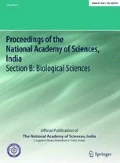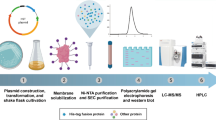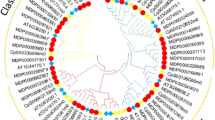Abstract
The aims of this study were identification of Δ1-pyrroline-5-carboxylate synthetase (P5CS) gene and effect of different concentrations of NaCl on P5CS gene expression level and some biochemical traits of L. draba seedlings. The 5-day-old L. draba seedlings were treated by different concentrations (0, 50, 100, 200 and 300 mM) of NaCl for 14 days. Identification of the P5CS gene was done by purification of total RNA, synthesis of cDNA library and amplification of the cDNA in the presence of specific primers followed by sequencing. The gene expression level of P5CS was done using real-time PCR method. Thereafter, the effect of salt stress was evaluated on peroxidase and catalase enzymes activities and carotenoids content, chlorophyll, total protein and proline contents. Identification and characterization of P5CS mRNA were performed and its sequence partially registered in gene bank. The data showed that P5CS gene expression level and the proline content increased with increasing concentrations of NaCl up to 300 mM. Peroxidase and catalase activities as well as the total protein content were enhanced by increasing the concentrations of NaCl in all samples. Chlorophyll and carotenoids contents were significantly decreased by salinity stress. According to the results, a direct relationship was found between proline content and P5CS gene expression level. Furthermore, these results also provide an insight into the response of this medicinal plant to salt stress.





Similar content being viewed by others
References
Rezvani M, Zaefarian F (2016) Hoary cress (Cardaria draba (L) Desv) seed germination ecology, longevity and seedling emergence. Plant Species Biol 31(4):280–287. https://doi.org/10.1111/1442-1984.12113
Jamshidi Goharrizi K, Amirmahani F, Salehi F (2019) Assessment of changes in physiological and biochemical traits in four pistachio rootstocks under drought, salinity and drought+salinity stresses. Physiol Plantarum. https://doi.org/10.1111/ppl.13042
Jamshidi Goharrizi K, Baghizadeh A, Kalantar M, Fatehi F (2019a) Combined effects of salinity and drought on physiological and biochemical characteristics of pistachio rootstocks. Sci Hortic 261(5):108970. https://doi.org/10.1016/j.scienta.2019.108970
Jamshidi Goharrizi K, Baghizadeh A, Kalantar M, Fatehi F (2019b) Assessment of changes in some biochemical traits and proteomic profile of UCB-1 pistachio rootstock leaf under salinity stress. J Plant Growth Regul. https://doi.org/10.1007/s00344-019-10004-3
Jamshidi Goharrizi K, Moosavi S, Amirmahani F, Salehi F, Nazari M (2019) Assessment of changes in growth traits, oxidative stress parameters and enzymatic and non-enzymatic antioxidant defense mechanisms in Lepidium draba plant under osmotic stress induced by polyethylene glycol. Protoplasma 257(2):459–473
Jamshidi Goharrizi K, Riahi-Madvar A, Rezaee F, Pakzad R, Jadid Bonyad F, Ghazizadeh Ahsaei M (2019) Effect of salinity stress on enzymes’ activity, ions concentration, oxidative stress parameters, biochemical traits, content of sulforaphane, and CYP79F1 gene expression level in lepidium draba plant. J Plant Growth Regul. https://doi.org/10.1007/s00344-019-10047-6
Pavlović I, Mlinarić S, Tarkowská D, Oklestkova J, Novák O, Lepeduš H, Bok VV, Brkanac SR, Strnad M, Salopek-Sondi B (2019) Early Brassica Crops Responses to Salinity Stress: A Comparative Analysis Between Chinese Cabbage, White Cabbage, and Kale. Frontiers in Plant Science 10 (450). https://doi.org/10.3389/fpls.2019.00450
Foyer CH, Noctor G (2003) Redox sensing and signalling associated with reactive oxygen in chloroplasts, peroxisomes and mitochondria. Physiol Plant 119(3):355–364. https://doi.org/10.1034/j.1399-3054.2003.00223.x
Hniličková H, Hnilička F, Martinkova J, Kraus K (2017) Effects of salt stress on water status, photosynthesis and chlorophyll fluorescence of rocket. Plant, Soil Environ 63(8):362–367. https://doi.org/10.17221/398/2017-PSE
Hayat S, Hayat Q, Alyemeni MN, Wani AS, Pichtel J, Ahmad A (2012) Role of proline under changing environments: a review. Plant Signal Behav 7(11):1456–1466. https://doi.org/10.4161/psb.21949
Rodino S, Butu M, Negoescu C, Caunii A, Cristina R, Butnariu M (2014) Spectrophotometric method for quantitative determination of nystatin antifungal agent in pharmaceutical formulations. Digest J nanomaterials biostructures 9(3):1215–1222
Chance B, Maehly AC (1955) [136] Assay of catalases and peroxidases. Methods Enzymol 2:764–775. https://doi.org/10.1016/S0076-6879(55)02300-8
Chandlee JM, Scandalios JG (1984) Analysis of variants affecting the catalase developmental program in maize scutellum. Theor Appl Genet 69(1):71–77. https://doi.org/10.1007/bf00262543
Lichtenthaler HK (1987) [34] Chlorophylls and carotenoids: Pigments of photosynthetic biomembranes. Methods Enzymol 148:350–382. https://doi.org/10.1016/0076-6879(87)48036-1
Bradford MM (1976) A rapid and sensitive method for the quantitation of microgram quantities of protein utilizing the principle of protein-dye binding. Anal Biochem 72(1):248–254. https://doi.org/10.1016/0003-2697(76)90527-3
Bates LS, Waldren RP, Teare ID (1973) Rapid determination of free proline for water-stress studies. Plant Soil 39(1):205–207. https://doi.org/10.1007/BF00018060
Jamshidi Goharrizi K, Dayton Wilde H, Amirmahani F, Mehdi Moemeni M, Zaboli M, Nazari M, Saeed Moosavi S, Jamalvandi M (2018) Selection and validation of reference genes for normalization of qRT-PCR gene expression in wheat (Triticum durum L) under drought and salt stresses. J Genet 97(5):1433–1444
Nasiri-Bezenjani MA, Riahi-Madvar A, Baghizadeh A, Ahmadi AR (2014) Rosmarinic acid production and expression of tyrosine aminotransferase gene in melissa officinalis seedlings in response to yeast extract. J Agric Sci Tech 16(4):921–930
Amirmahani F, Jamshidi Goharrizi K (2018) phylogenetic analysis of three long non-coding RNA genes: AK082072, AK043754 and AK082467. J Genet Resour 4(1):56–64. https://doi.org/10.22080/jgr.2018.14224.1103
Felsenstein J (1985) Confidence limits on phylogenies: an approach using the bootstrap. Evolution 39(4):783–791. https://doi.org/10.1111/j.1558-5646.1985.tb00420.x
Tamura K, Nei M (1993) Estimation of the number of nucleotide substitutions in the control region of mitochondrial DNA in humans and chimpanzees. Mol Biol Evol 10(3):512–526. https://doi.org/10.1093/oxfordjournals.molbev.a040023
Swathy Lekshmi S, Jayadev A (2017) Influence of salt stress on the morphological physiological activity and anatomy of Cow pea plant (Vigna unguiculata). IJAR 3(8):281–288
Grzeszczuk M, Salachna P, Meller E (2018) changes in photosynthetic pigments, total phenolic content, and antioxidant activity of salvia coccinea Buc’hoz Ex Etl induced by exogenous salicylic acid and soil salinity. Molecules (Basel, Switzerland) 23(6):1296. https://doi.org/10.3390/molecules23061296
Wu Y, Jin X, Liao W, Hu L, Dawuda MM, Zhao X, Tang Z, Gong T, Yu J (2018) 5-Aminolevulinic acid (ALA) alleviated salinity stress in cucumber seedlings by enhancing chlorophyll synthesis pathway. Frontiers plant sci 9:635–635. https://doi.org/10.3389/fpls.2018.00635
Pospíšil P (2016) Production of reactive oxygen species by photosystem ii as a response to light and temperature stress. Frontiers plant sci 7:1950–1950. https://doi.org/10.3389/fpls.2016.01950
Akcin A, Yalcin E (2016) Effect of salinity stress on chlorophyll, carotenoid content, and proline in salicornia prostrata pall and suaeda prostrata pall subsp prostrata (Amaranthaceae). Brazilian J Botany 39(1):101–106. https://doi.org/10.1007/s40415-015-0218-y
Cerullo G, Polli D, Lanzani G, De Silvestri S, Hashimoto H, Cogdell RJ (2002) Photosynthetic light harvesting by carotenoids: detection of an intermediate excited state. Science 298(5602):2395. https://doi.org/10.1126/science.1074685
Verma S, Mishra SN (2005) Putrescine alleviation of growth in salt stressed Brassica juncea by inducing antioxidative defense system. J Plant Physiol 162(6):669–677. https://doi.org/10.1016/j.jplph.2004.08.008
Shokri-Gharelo R, Noparvar PM (2018) Molecular response of canola to salt stress: insights on tolerance mechanisms. PeerJ 6:e4822. https://doi.org/10.7717/peerj.4822
Guan C, Huang Y-H, Cui X, Liu S-J, Zhou Y-Z, Zhang Y-W (2018) Overexpression of gene encoding the key enzyme involved in proline-biosynthesis (PuP5CS) to improve salt tolerance in switchgrass (Panicum virgatum L). Plant cell report 37(8):1187–1199. https://doi.org/10.1007/s00299-018-2304-7
Acknowledgements
The authors gratefully acknowledge support of this work by the Sahab Gostar Kerman and Barafza Keshavarze Pars Companies.
Author information
Authors and Affiliations
Corresponding author
Ethics declarations
Conflict of interest
The authors declare that they have no conflict of interest.
Additional information
Publisher's Note
Springer Nature remains neutral with regard to jurisdictional claims in published maps and institutional affiliations.
Significance statement
Proline content and P5CS gene expression level had a direct relationship together and also with increasing concentration of salinity stress. Also, enzymatic and non-enzymatic antioxidant defense systems were enhanced in response to salt stress significantly.
Electronic supplementary material
Below is the link to the electronic supplementary material.
Rights and permissions
About this article
Cite this article
Pakzad, R., Goharrizi, K.J., Riahi-Madvar, A. et al. Identification of Lepidium draba Δ1-pyrroline-5-carboxylate Synthetase (P5CS) and Assessment of its Expression Under NaCl stress: P5CS Identification in L. draba plant. Proc. Natl. Acad. Sci., India, Sect. B Biol. Sci. 91, 195–203 (2021). https://doi.org/10.1007/s40011-020-01207-w
Received:
Revised:
Accepted:
Published:
Issue Date:
DOI: https://doi.org/10.1007/s40011-020-01207-w




